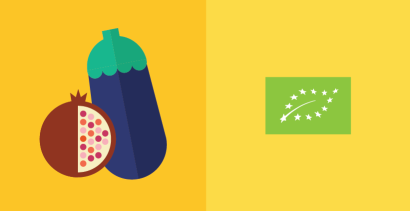Organic wine
Last Updated : 24 January 2019Until recently, wine could only be labelled as ‘made of organic grapes’. However, after a new legislation was implemented in 2012 within the EU, it is possible to label wine as an organic food product.1 Organic wine, however, still remains a niche product on the European market.
The ORWINE project
Between 2006 and 2009, the EU-funded project ORWINE examined environmental, health, market and product quality issues related to European wine industry in order to develop guidelines for organic production. As a result, the project provided scientific evidence supporting the development of a legislative framework for organic wine production. The European legislation was then advanced based on this research.
Organic vineyards
Conventional viticulture (grape production) is among the most pesticide-consuming agricultural systems.2 This can result in pests building resistance to pesticides and cause a negative impact on non-targeted organisms.2 Vineyards that implement organic farming techniques do so with the aim of improving soil quality, bringing about an equilibrium in the ecosystem of the vineyard, and encouraging natural defense mechanisms of the plants.
In Europe, vineyards are mostly located in temperate regions that often host rare and endangered varieties of plants and invertebrates.3 This makes the natural vineyard ecosystem an important one to preserve.4,5 Organic farming encourages the proliferation of beneficial arthropods in the vineyard which in turn help in managing pests.3
According to some recent studies, organic wines contain lower amounts of pesticides compared to conventional wines, but further research is required to fully understand the impact of organic viticulture on wine.6,7
Production techniques and additives
Whilst organic grapes form the basis of organic wine, this is not enough to label the wine as organic. The aim of organic winemaking is to minimise external physical and chemical interventions so that the final product is not affected by multiple processing steps. Various techniques used for conventional winemaking such as the elimination of sulphur dioxide by physical processes, nano or ultra-filtration, and heat treatments above 70°C, among others, are not permitted in the organic vinification process.
The regulation provides a list of permitted additives that can be added to the wine to extend its shelf life and maintain the aroma and taste. All additives of natural origin which are used in conventional vinification are allowed.
Challenges
Nearly 90% of the organic grapes produced come from Europe; and Spain, France and Italy are the largest producers of organic wine, globally.8 In the recent years, organic grape and wine production have expanded to other countries like China and Turkey as well.9
However, in spite of the increasing area under organic cultivation, several factors play a role in slowing down the progress of organic viticulture. These include unreliable yields, issues with pest management, and the need to educate consumers about organic products.10 Consumers are often unwilling to pay higher cost attached to these wines and remain skeptical regarding quality.11,12,13 Organic wine production, therefore, is a challenging process because growers and winemakers are expected to produce high quality wines while restricting their farming and wine production techniques to those permitted by the organic legislation.
References
- EC Regulation 203/2012. Commission Regulation 203/2012/EC of 8 March 2012 amending Regulation (EC) No 889/2008 laying down detailed rules for the implementation of Council Regulation (EC) No 834/2007, as regards detailed rules on organic wine. Official Jou
- Aubertot JN, et al. (2005). Pesticides, agriculture et environnement. Réduire l’utilisation des pesticides et en limiter les impacts environnementaux. Rapport d’expertise scientifique collective, INRA et Cemagref.
- Provost C & Pedneault K (2016). The organic vineyard as a balanced ecosystem: Improved organic grape management and impacts on wine quality. Scientia Horticulturae 208: 43-56.
- Gliessman SR (2000). Agroecosystem Sustainability: Developing Practical Strategies, first edition. CRC Press, Boca Raton, FL.
- Isaia M, Bona F & Badino G (2006). Influence of landscape diversity and agricultural practices on spider assemblage in Italian vineyards of Langa Astigiana (Northwest Italy). Environmental Entomology. 35: 297–307.
- Bonn MA, Cronin Jr JJ & Cho M (2016). Do environmental sustainable practices of organic wine suppliers affect consumers’ behavioral intentions? The moderating role of trust. Cornell Hospitality Quarterly 57(1): 21-37.
- Cabras P & Angioni A (2000). Pesticide residues in grapes, wine, and their processing products. Journal of Agricultural and Food Chemistry 48(4): 967-973.
- Confederation of British Industry (CBI). (2013). CBI Product Factsheet: Organic wine in Europe.
- Willer H & Lernoud J (2017). The World of Organic Agriculture- Statistics & Emerging Trends 2017. Research Institute of Organic Agriculture (FiBL). Frick, and IFOAM-Organics International. Bonn.
- Willer H. (2008). Organic Viticulture in Europe: Development and current statistics.
- Iordachescu A, Moore A & Iordachescu G (2009). Consumer perceptions of organic wine. The Annals of the University Dunarea de Jos of Galati Fascicle VI Food Technology 34.
- Ogbeide OA (2015). Consumer willingness to pay a premium for organic wine: discriminant analysis. Journal of Agribusiness and Rural Development. 1: 24–42.
- Rojas-Méndez JI, Le Nestour M & Rod M (2015). Understanding attitude and behavior of Canadian consumers toward organic wine. Journal of Food Products Marketing 21(4): 375-396.



